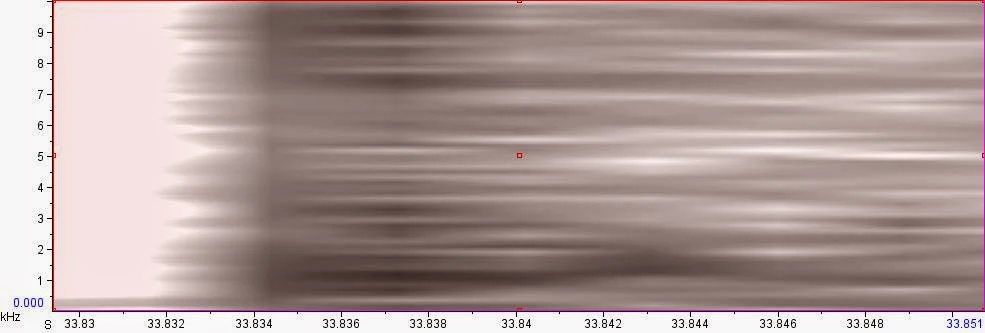I fired a .308 Winchester from a picnic table approximately 15 yards from the mike. The mike was to my left. Approximately 18 yards to my right was a barn. (Note added later: The barn was not immediately to my right but also a wee bit downrange. This note prompted by a sharp-eyed reader, Mr Oldnfo) Between me and the target, and slightly to the right, was a dense arborvitae bush.
Both full power and subsonic (8 grains Unique and 170 grain cast bullet) loads were evaluated. I am still playing with the software so this will be pretty crude.
KU time trace
 |
| Subsonic load. Vertical scale changed to highlight similarities in trace with three separate peaks. Peak KU is 6. If memory serves, that is a 20dB difference, or 10^2 difference in power. |
Spectral traces
 |
| Subsonic load. Trace is notable in that there is a bit of a valley in the 4000Hz to 7000Hz range with heaviest content between 1000Hz and 2400Hz. |
 |
| For comparison, this is a four second snippet of Dido, a female vocalist notable for a strong midrange (2KHz-to-4KHz) and breathy topnotes (7KHz-to-12KHz. |
Why is spectral content important?
Spectral content is important for two reasons. One reason is that humans do not hear all frequencies equally. Most humans have two acuity peaks, the most acute hearing is at about 3000 Hz and a smaller peak is at 1000Hz.
| Image from HERE. These are equal-loudness lines, so traces are inverted. That is, what I am calling peaks show up as valleys. |
The other reason it is important is to design efficient sound attenuation structures.
If you can remember only two thing....a quarter wavelength for 1200Hz will be three inches or 75mm and wavelength gets small as frequency gets large. Everything else can be easily ratioed out. The length of a quarter wavelength for 2400Hz is half that of 1200Hz, 3600Hz is 1/3, 4800Hz is 1/4, 600Hz is 2X and so on.
The table below lists frequencies and their quarter wavelength at normal temperatures.
| Frequency (Hz) | Inches | mm |
| 800 | 4.1 | 103 |
| 1000 | 3.2 | 83 |
| 1500 | 2.2 | 55 |
| 2000 | 1.6 | 41 |
| 3000 | 1.1 | 28 |
| 4000 | 0.8 | 21 |
| 5000 | 0.6 | 17 |
| 6000 | 0.5 | 14 |
| 7000 | 0.5 | 12 |
| 8000 | 0.4 | 10 |
The designer obtains maximum sound attenuation by placing the sound absorbing (or anti-resonance) materials one quarter wavelength out from hard, reflective surfaces.
For example, supposed you worked in a daycare and wanted to hang banners to knock down the shrill screaming. Further, suppose you decided to target that 3000Hz hearing acuity peak mentioned earlier. Optimum attenuation will occur when the banners are mounted so there is a one inch (25mm) air gap behind them. Knowing that, the designer might choose to hang them from 2" (50mm) diameter curtain rods made from PVC pipe.
Anti-resonance materials include materials like wood lattice, horticultural shade cloth or even snow fence. The key points are to have close to 50% open area and a hard, reflective backing an appropriate distance (that quarter wavelength I keep talking about) behind them.
Anti-resonance materials to have spikier attenuation characteristics (bigger openings = spikier performance) than fabrics but they are much more economical to apply to overhead surfaces like the roofs of shooting ranges. If mounted to standard 2X4s, the panels will nominally be 3.5" (about 90mm) from the bottom of the ceiling. Good enough to eat up much of the 1000Hz content of the smaller acuity peak.
Too ambitious?
How about making an open ended "dog house" and lining the insides with acoustical absorbing materials? Not something you would carry squirrel hunting but it is something that is easily within the scope of a backyard shooting range.
And now, a commercial message:
This work was sponsored, in part, by Hearingpath.com



Actually I believe you have these two reversed... "Reflected "boom" at 30.87 and 30.93, presumably from arborvitae and barn respectively."
ReplyDeleteLooking at the sharpness of the echo at 30.87 would indicate a flat plate reflection and the distributed one at 30.93 looks more like what you'd expect in an attenuated echo.
I cheated. I paced out distances. The total distance from the muzzle to the mike was 16 paces. The total distance from the muzzle-to-arborvitae-to-mike was 32 paces. The total distance from the muzzle-to-barn-to-mike was 56 paces. So figuring 33 inches to the pace and 1100 fps for sound I get a time difference of 0.040 seconds between the muzzle boom and the muzzle-bush-mike boom and a time difference of 0.100 seconds for the muzzle-barn-mike path.
ReplyDeleteYou are right that one would expect a sharper echo off the barn. What I failed to communicate is that the barn was not directly to my side but somewhat forward of it.
I will go back and make that clearer in the text.
Thanks for reading and thanks for thinking about the pictures. You are a sharp guy.
-Joe
I do this stuff for a living... except underwater... :-)
ReplyDelete